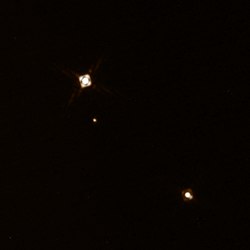| Observation data Epoch J2000 Equinox J2000 | |
|---|---|
| Constellation | Centaurus |
| Right ascension | 14h 54m 25.30919s[1] |
| Declination | −34° 08′ 34.0412″[1] |
| Apparent magnitude (V) | 7.07[2] |
| Characteristics | |
| Spectral type | A1V + G + K[3] |
| Astrometry | |
| Radial velocity (Rv) | 0.30 ± 1.3[4] km/s |
| Distance | 351+15 −12 ly (107.9+4.5 −3.7[5] pc) |
| A | |
| Proper motion (μ) | RA: −30.702[6] mas/yr Dec.: −30.774[6] mas/yr |
| Parallax (π) | 9.7480 ± 0.0357 mas[6] |
| Distance | 335 ± 1 ly (102.6 ± 0.4 pc) |
| Absolute magnitude (MV) | 1.89[7] |
| BC | |
| Proper motion (μ) | RA: −31.523[8] mas/yr Dec.: −31.047[8] mas/yr |
| Parallax (π) | 9.3021 ± 0.0633 mas[8] |
| Distance | 351 ± 2 ly (107.5 ± 0.7 pc) |
| Orbit[3] | |
| Primary | A |
| Companion | BC |
| Period (P) | 3556 ± 36 yr |
| Semi-major axis (a) | 3.56 ± 0.03″ (349 ± 28 au) |
| Eccentricity (e) | 0.13 ± 0.05 |
| Inclination (i) | 45 to 65° |
| Longitude of the node (Ω) | 265 ± 20[note 1]° |
| Periastron epoch (T) | B 502 ± 33 |
| Argument of periastron (ω) (secondary) | 145.3 ± 15[note 2]° |
| Details | |
| Age | 21.9+4.1 −3.8[5] Myr |
| HD 131399 A | |
| Mass | 1.95+0.08 −0.06[7] M☉ |
| Radius | 1.51+0.13 −0.10[7] R☉ |
| Luminosity | 14.8+2.6 −2.2[7] L☉ |
| Surface gravity (log g) | 4.37±0.10[7] cgs |
| Temperature | 9,200±100[7] K |
| Rotational velocity (v sin i) | 26±2[7] km/s |
| HD 131399 B | |
| Mass | 0.95±0.04[5] M☉ |
| Surface gravity (log g) | 4.40±0.03[5] cgs |
| Temperature | 4,890+190 −170[5] K |
| HD 131399 C | |
| Mass | 0.35±0.04[5] M☉ |
| Surface gravity (log g) | 4.45±0.05[5] cgs |
| Temperature | 3,460±60[5] K |
| Other designations | |
| Database references | |
| SIMBAD | data |
HD 131399 is a star system in the constellation of Centaurus. Based on the system's electromagnetic spectrum, it is located around 350 light-years (107.9 parsecs) away.[5] The total apparent magnitude is 7.07,[5] but because of interstellar dust between it and the Earth, it appears 0.22 ± 0.09 magnitudes dimmer than it should be.[5]
The brightest star, is a young A-type main-sequence star, and further out are two lower-mass stars.[3] A Jupiter-mass planet or a low-mass brown dwarf was once thought to be orbiting the central star, but this has been ruled out.[5][9]
- ^ a b van Leeuwen, F.; et al. (2007). "Validation of the new Hipparcos reduction". Astronomy and Astrophysics. 474 (2): 653–664. arXiv:0708.1752. Bibcode:2007A&A...474..653V. doi:10.1051/0004-6361:20078357. S2CID 18759600.
- ^ Høg, E.; et al. (2000). "The Tycho-2 catalogue of the 2.5 million brightest stars". Astronomy and Astrophysics. 355: L27–L30. Bibcode:2000A&A...355L..27H.
- ^ a b c Wagner, K.; Apai, D.; Kasper, M.; Kratter, K.; McClure, M.; Robberto, M.; Beuzit, J.-L. (2016). "Direct imaging discovery of a Jovian exoplanet within a triple-star system". Science. 353 (6300): 673–8. arXiv:1607.02525. Bibcode:2016Sci...353..673W. doi:10.1126/science.aaf9671. PMID 27386921. S2CID 206650422. (Retracted, see doi:10.1126/science.abq1709, PMID 35420970, Retraction Watch)
- ^ Kharchenko, N. V.; et al. (2007). "Astrophysical supplements to the ASCC-2.5: Ia. Radial velocities of ~55000 stars and mean radial velocities of 516 Galactic open clusters and associations". Astronomische Nachrichten. 328 (9): 889. arXiv:0705.0878. Bibcode:2007AN....328..889K. doi:10.1002/asna.200710776. S2CID 119323941.
- ^ a b c d e f g h i j k l Nielsen, Eric L.; et al. (2017). "Evidence that the Directly-Imaged Planet HD 131399 Ab is a Background Star". The Astronomical Journal. 154 (6): 218. arXiv:1705.06851. Bibcode:2017AJ....154..218N. doi:10.3847/1538-3881/aa8a69. S2CID 55138870.
- ^ a b c Brown, A. G. A.; et al. (Gaia collaboration) (2021). "Gaia Early Data Release 3: Summary of the contents and survey properties". Astronomy & Astrophysics. 649: A1. arXiv:2012.01533. Bibcode:2021A&A...649A...1G. doi:10.1051/0004-6361/202039657. S2CID 227254300. (Erratum: doi:10.1051/0004-6361/202039657e). Gaia EDR3 record for this source at VizieR.
- ^ a b c d e f g Cite error: The named reference
przbylla2017was invoked but never defined (see the help page). - ^ a b c Brown, A. G. A.; et al. (Gaia collaboration) (2021). "Gaia Early Data Release 3: Summary of the contents and survey properties". Astronomy & Astrophysics. 649: A1. arXiv:2012.01533. Bibcode:2021A&A...649A...1G. doi:10.1051/0004-6361/202039657. S2CID 227254300. (Erratum: doi:10.1051/0004-6361/202039657e). Gaia EDR3 record for this source at VizieR.
- ^ Wagner, Kevin; Apai, Dániel; Kasper, Markus; Kratter, Kaitlin; McClure, Melissa; Robberto, Massimo; Beuzit, Jean-Luc (2022-04-15). "Retraction". Science. 376 (6590): 255. Bibcode:2022Sci...376..255W. doi:10.1126/science.abq1709. ISSN 0036-8075. PMID 35420970. S2CID 248180563.
Cite error: There are <ref group=note> tags on this page, but the references will not show without a {{reflist|group=note}} template (see the help page).
